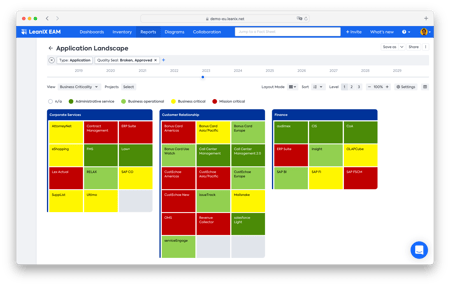Introduction
When organizations implement enterprise architecture, they are investing in the long-term health and future success of the business.
Enterprise architects align the IT landscape with the business strategy and create a set of standards that streamline processes and increase agility at all levels of the organization — key values of enterprise architecture.
But how do you report the success of EA to your stakeholders? What are the enterprise architecture metrics that can clearly define the success of the project?
📚 2023 Gartner® Magic Quadrant™ for Enterprise Architecture Tools
Common enterprise architecture metrics
Enterprise architecture metrics are a set of predetermined ways architects and stakeholders measure the success of EA. Metrics track the performance of how enterprise architecture and its strategy affect the alignment, agility, and effectiveness of business. These can range from short to long-term, depending on the reason EA was implemented.
Measuring EA effectiveness is key to determining how efficiently new processes or services serve the customer, provide an opportunity for business/IT innovation, and allow actionable decision-making.
Here are a few of the most common examples you can start with.
Strategic
These metrics are important for monitoring the business and IT alignment and reporting to high-level stakeholders involved in the project. Therefore, strategic metrics can track overall IT costs and the involvement of EA with business objectives on a longer timescale.
1. Total IT cost savings
One of the best indicators that your EA efforts are working is the total cost of money saved on IT services, applications, etc. Enterprise architecture is used to simplify the complex IT landscape. By evaluating capabilities, processes, applications, etc., enterprise architects are able to deliver cost savings on a regular basis.
Examples: Retiring legacy systems, consolidating licenses, modernizing and rationalizing applications, standardizing IT infrastructure, or migrating to the cloud.
2. IT portfolio Total Cost of Ownership
As previously mentioned, one way to lower costs is through application rationalization. IT application portfolios belonging to large organizations will consist of hundreds (or even thousands) of different intersecting applications, including SaaS, data storage, servers, hardware, etc.
Rationalizing these will reduce the IT complexity and consequently remove management, support, and training costs, as well as unnecessary communication to lower the total cost of ownership (TCO).
Examples: Lower TCO by eliminating unused apps, retiring redundant software, and standardizing common technology platforms.
3. Cost for annual IT projects
One of the important by-products of enterprise architecture is that the cost of annual IT projects will be reduced. The cost of each project will be lower as EA acts as a single, comprehensive view into the IT landscape which drastically reduces the time for project preparation.
Example: When business plans to invest in IT projects such as application rationalization, application modernization, post-merger integrations, or business transformations, it can use EA tools to gather affected IT components, visualize the IT roadmap, and manage changes.
4. Business objectives supported by IT roadmap
One way to measure the success of enterprise architecture is by creating IT roadmaps that support business objectives. The more objectives the IT roadmap supports, the better we can conclude the success of EA within the business, and the higher quality of the end result can be.
An IT roadmap is a visual way for a company to develop and share a strategy for IT initiatives. Such roadmaps are a key part of enterprise architecture to support the ongoing innovation and success of the business.
Examples: How many of the current business objectives are supported by the IT stack? How often is EA involved in business strategy?






/EN-WP-EA-Tomorrow-Resource_Page_Thumbnail.png?width=260&height=171&name=EN-WP-EA-Tomorrow-Resource_Page_Thumbnail.png)
/EN-TopStakeholderQuestions-Poster_Resource_Page_Thumbnail.png?width=260&height=171&name=EN-TopStakeholderQuestions-Poster_Resource_Page_Thumbnail.png)
![How to Answer the Top Questions of Enterprise Architecture Stakeholders [Poster]: Align business and IT and learn how to support each of their needs. »](https://no-cache.hubspot.com/cta/default/2570476/9bf74c6d-ebaf-41f4-ac30-0a0282b2fe43.png)
